Ambitious organizational visions often fall short when daily work loses sight of long-term goals. Strategic goals bridge this gap, transforming big-picture ideas into clear, actionable priorities that align teams and resources for meaningful progress.
This guide walks you through how to create effective strategic goals, featuring 75+ real-world examples and step-by-step methods for setting and prioritizing objectives. Learn how to connect your vision to everyday work — so your teams can focus, execute, and deliver results with confidence.
Try monday work managementKey takeaways
- Strategic goals are 3-5 year objectives that set the long-term direction for your business. Unlike short-term operational goals, they focus on broader transformations that shape market position, capabilities, or culture.
- Effective strategic goals must be measurable, time-bound, and aligned with your mission. Balance ambitious targets that inspire teams with realistic expectations based on your actual capabilities.
- Limit your focus to 4-6 strategic priorities at a time. Concentrating resources ensures progress on the goals that matter most, instead of spreading efforts too thin.
- Review strategic goals annually with quarterly check-ins to track progress and adapt to market changes. Regular milestone tracking helps you course-correct without losing momentum toward your vision.
- Use monday work management to connect daily work to strategic objectives through transparent project tracking and real-time dashboards. This keeps teams aligned and shows how their efforts contribute to long-term success.
What are strategic goals?
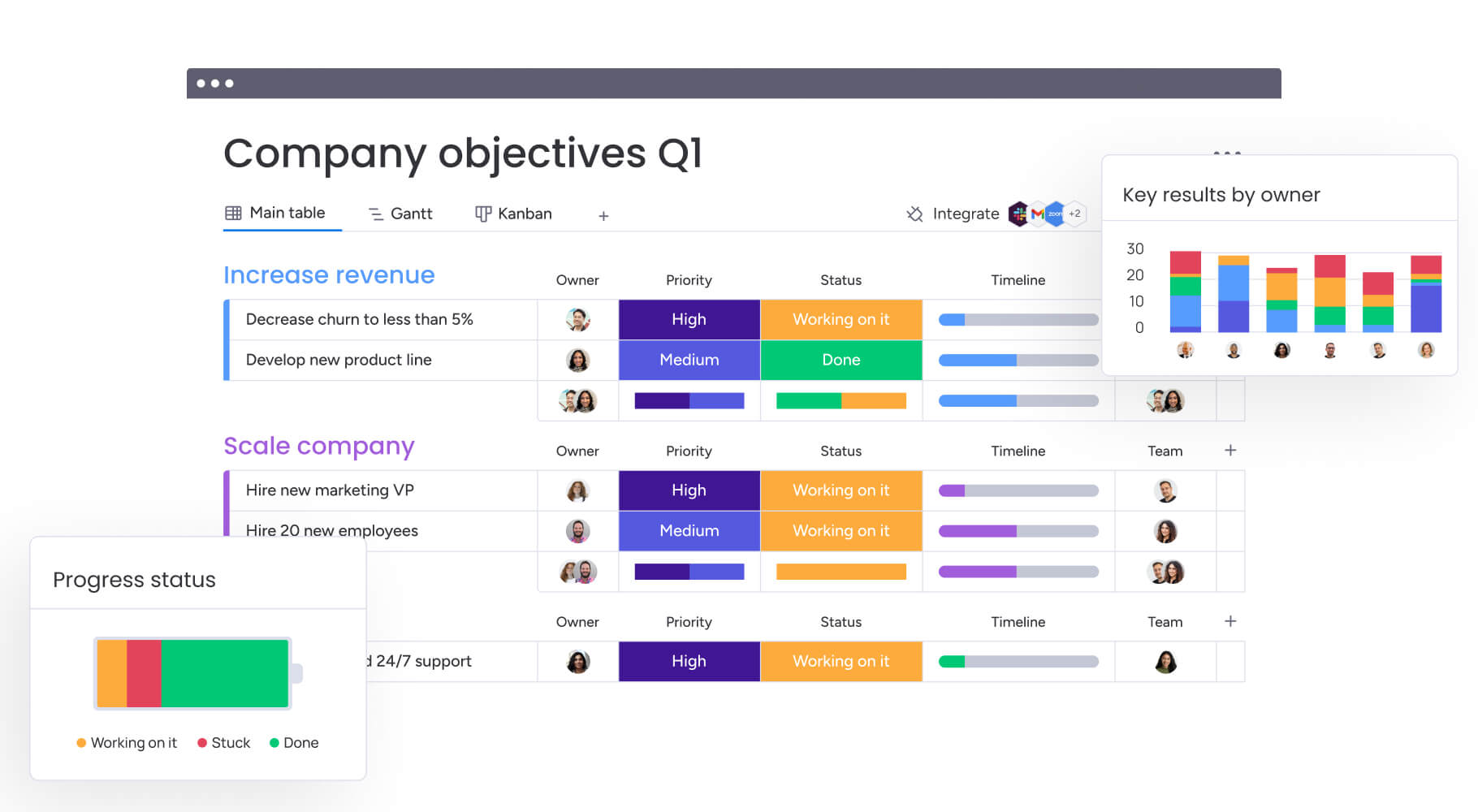
Strategic goals are long-term objectives that guide your organization toward its vision over the next 3-5 years. They focus on transformational outcomes that fundamentally change how your business operates or competes in the market.
Think of strategic goals as your North Star. They help you allocate resources, prioritize initiatives, and measure progress toward meaningful business outcomes with goal management. When your teams understand how their work connects to these broader objectives, they make decisions that drive the organization forward through operational planning.
Strategic goals definition
Strategic goals are measurable, long-term business objectives that align with your organization’s mission and vision. They typically span multiple years and require coordinated effort across departments to achieve.
Here’s what makes them different from your day-to-day operational goals:
- Timeframe: 3-5 years instead of quarterly or annual
- Scope: Company-wide transformation rather than department-specific improvements
- Impact: Fundamental change in market position, capabilities, or business model
- Resources: Significant investment of time, budget, and talent across multiple teams
Why strategic goals matter for business success
Strategic goals transform vision into reality. Without them, organizations drift from one urgent priority to the next, reacting instead of building a strategic plan. Right now, the big 3 focus areas for most organizations are digital transformation, sustainability, and agility. The challenge? Markets and customer expectations are changing so quickly that even the best five-year plan can feel outdated after one.
That’s why tools like monday work management matter. They give you a live picture of your long-term strategic initiatives — so instead of guessing whether you’re on track, you can see progress, spot risks early, and keep every department accountable.
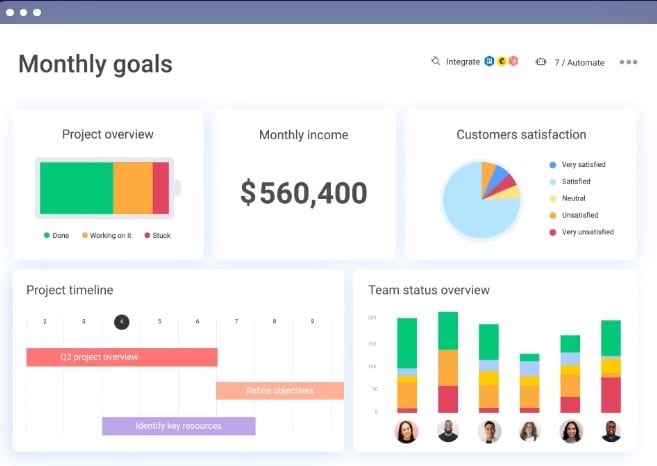
Strategic goals vs objectives, strategies, and tactics
When setting long-term direction, it’s easy to confuse goals, objectives, strategies, and tactics. Each serves a different purpose, but together they form a hierarchy that connects your company’s vision to day-to-day execution. Here’s a quick comparison:
| Level | Time Frame | Scope | Purpose | Example |
|---|---|---|---|---|
| Strategic Goals | 3–5 years | Organization-wide, transformational | Define long-term direction and vision | Become market leader in renewable energy |
| Strategic Objectives | 1–2 years | Specific, measurable, often cross-departmental | Break goals into concrete, measurable milestones | Launch 5 new solar products by Q4 2026 |
| Business Strategies | 1–3 years | Department or initiative-specific approaches | Outline the “how”—approaches to achieve goals | Invest in R&D, expand into new regions, form strategic partnerships |
| Tactics | Weeks to months | Team or project-level actions | Execute strategies through daily activities and tasks | Run targeted marketing campaigns, pilot new solar product, negotiate supplier contracts |
This planning hierarchy creates alignment from the C-suite to every individual contributor. When every layer — from vision-setting to daily execution — is clearly defined and connected, teams understand how their work advances transformational business outcomes. With monday work management, it’s easier to visualize and manage these connections, ensuring that all actions ladder up to your top strategic priorities.
Try monday work management
Essential characteristics of effective strategic goals
Not all long-term objectives qualify as effective strategic goals. The most successful organizations craft goals that drive meaningful progress rather than just consuming resources.
Purpose-driven and vision-aligned
Strategic goals must connect directly to your organization’s core mission. This alignment ensures that achieving the goals actually advances your fundamental purpose.
Purpose-driven goals foster employee engagement because they connect to something meaningful beyond financial metrics. The absence of this connection can lead to decreased productivity, lower employee satisfaction, and reduced profitability for an organization. A healthcare company setting a goal to “improve patient outcomes by 30%” reinforces its commitment to quality care.
Measurable with defined success metrics
Effective strategic goals include quantifiable outcomes and specific KPIs. This measurability enables progress tracking and course correction when needed, which is critical, as employees who understand how success is measured are 2x more likely to feel motivated, according to The world of work report by monday.com.
You can measure success through:
- Revenue targets: Annual recurring revenue, market share percentages
- Customer metrics: Satisfaction scores, retention rates, lifetime value
- Operational indicators: Efficiency improvements, quality benchmarks
- Innovation measures: New product launches, patent filings
Time-bound with defined milestones
Strategic goals need specific timeframes and interim checkpoints. These milestones create urgency and allow for adjustments along the way. For example, “Expand into 3 new markets by Q4 2026, with one market launch per year” provides both an end date and interim milestones your teams can work toward.
Ambitious yet achievable
Balance stretch targets that inspire teams with realistic expectations that maintain credibility. Goals should require significant effort while remaining possible given your resources and capabilities.
This balance requires honest assessment of organizational capacity and market conditions. Goals that are too easy fail to drive change, while impossible goals demotivate teams.
Adaptable to market changes
Strategic goals should remain flexible as conditions evolve. Regular review cycles help you adapt goals without losing focus or momentum. With real-time visibility into goal progress, monday work management supports this adaptability by letting you quickly adjust timelines and resources as circumstances change.
75+ strategic goal examples by business area
To help you spark inspiration and shape your own roadmap, we’ve curated a list of high-impact strategic goal examples spanning finance, customer experience, growth, innovation, operations, and more. Use these as a starting point to clarify your priorities and set measurable targets that align your teams and move your organization forward.
Financial strategic goals
Financial strategic goals provide the foundation for sustainable growth and improved profitability. These goals help organizations set clear targets around revenue, costs, margins, and financial health, ensuring resources are used effectively and business growth is measurable over time.
- Achieve $50 million in annual recurring revenue by 2027
- Increase revenue per customer by 40% through upselling
- Expand into 5 new markets generating $10 million combined
- Improve gross margins from 35% to 45%
- Reduce customer acquisition costs by 30%
- Increase cash reserves by 25% to strengthen financial resilience
- Secure $15 million in new strategic investments by 2026
Customer experience strategic goals
Customer experience strategic goals focus on building loyalty, enhancing satisfaction, and ensuring every touchpoint delivers value. By prioritizing customer-centric objectives, you can drive retention, boost referrals, and create advocates for your brand.
- Achieve Net Promoter Score of 70+ across all segments
- Reduce churn rate to below 5% annually
- Implement AI-powered 24/7 chatbot support for premium clients
- Launch loyalty program increasing repeat purchases by 30%
- Use AI-driven segmentation to personalize communications for the top 20% of customers
- Reduce average customer support resolution time to under 2 hours
- Achieve a 95%+ customer satisfaction (CSAT) score on post-interaction surveys

Growth and market expansion strategic goals
Growth and market expansion goals empower organizations to broaden their reach, enter new territories, and seize emerging opportunities. These objectives support scaling efforts and position your business at the forefront of your industry.
- Capture 25% market share in enterprise software
- Launch operations in 3 new countries within 24 months
- Establish partnerships with 10 industry leaders
- Develop franchising model for regional growth
- Double the number of active channel partners
- Introduce two new product lines tailored for emerging markets
- Achieve 20% year-over-year growth in new customer acquisitions
Operational excellence strategic goals
Operational excellence strategic goals streamline processes, improve efficiency, and enhance quality across the organization. These outcomes drive down costs, reduce errors, and create a culture of continuous improvement.
- Reduce product development cycle time by 40%
- Achieve 99.9% system uptime for critical applications
- Implement zero-waste manufacturing processes
- Automate 80% of manual data entry with AI document processing
- Achieve ISO 9001 certification by 2026
- Reduce operational costs by 25% through process optimization
- Increase first-pass yield in manufacturing to 98% or higher
Innovation and technology strategic goals
Innovation and technology goals ensure your organization stays ahead of the curve, leveraging new tools and ideas to create competitive advantage. These objectives foster a culture of creativity, experimentation, and tech-enabled transformation.
- Migrate 100% of legacy systems to cloud platforms
- Launch 3 AI-powered product features to reduce customer churn
- File 10 new patents annually, including 2 in AI/ML innovation areas
- Develop proprietary analytics platform
- Implement blockchain for supply chain transparency
- Establish an annual company-wide innovation challenge to source new ideas
- Adopt agile development methodologies across all IT projects by 2025
People and culture strategic goals
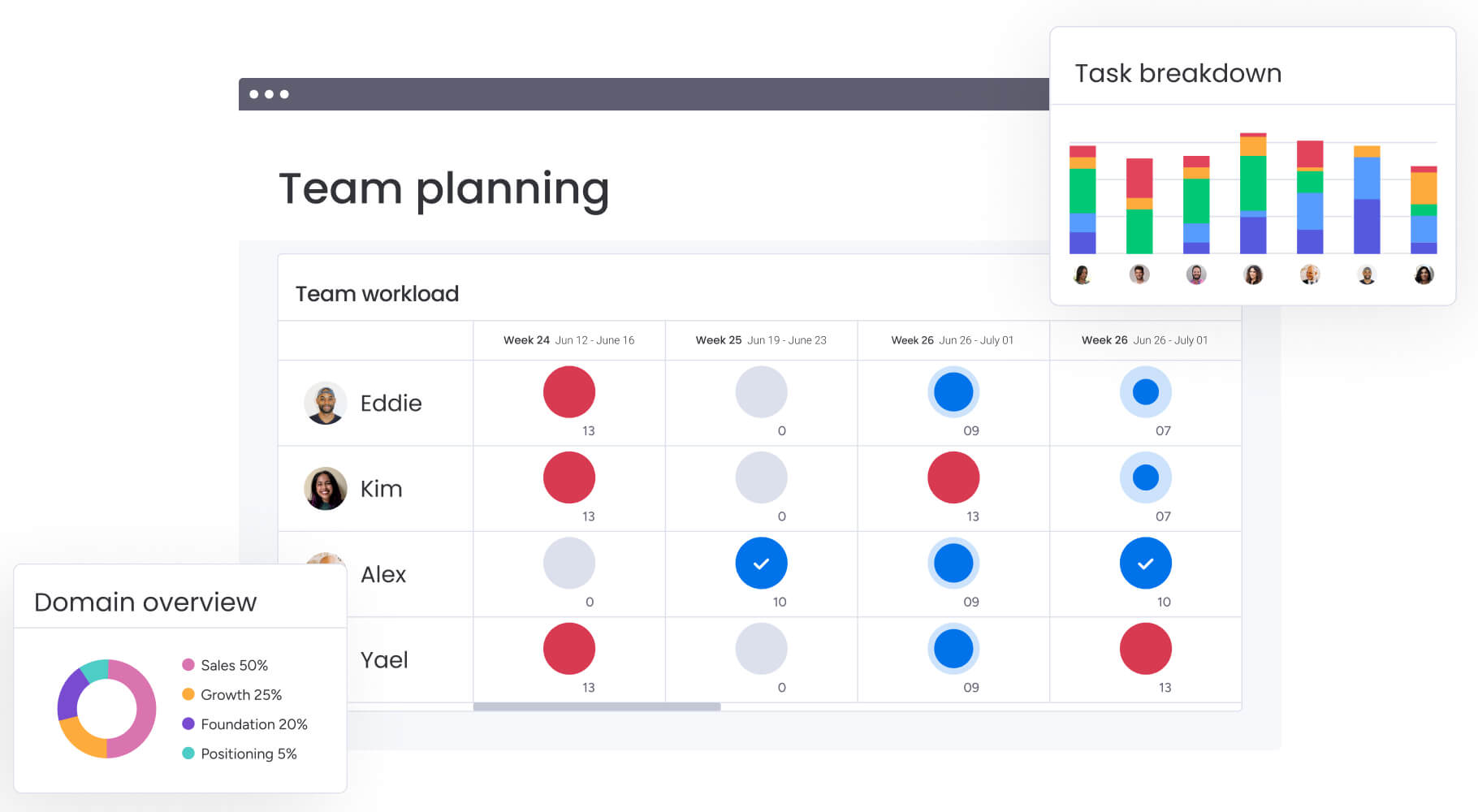
People and culture goals build an inclusive, high-performing workplace with a strong sense of purpose and belonging. These objectives drive engagement, reduce turnover, and empower employees to reach their full potential.
- Achieve 90% employee satisfaction scores
- Reduce turnover to below 10%
- Build diverse leadership with 50% underrepresented groups
- Provide 40 hours of training per employee annually
- Establish formal mentorship program company-wide (matching mentors/mentees using AI-driven skills mapping)
- Earn recognition as a “Best Place to Work” in industry rankings
- Achieve 100% pay equity across all roles and levels
Sustainability and ESG strategic goals
ESG goals meet stakeholder expectations while creating long-term value. In fact, Beyond Checking the Box, an IBM Institute for Business Value (IBV) survey of 5,000 C-suite executives across 22 countries shows that organizations embedding sustainability achieve a 16% higher rate of revenue growth and are 52% more likely to outperform peers on profitability.
- Achieve carbon neutrality by 2028
- Source 100% materials from sustainable suppliers
- Contribute $1 million annually to community programs
- Eliminate single-use plastics by 2026
- Obtain B Corp certification by 2027
- Reduce company-wide water usage by 35% over five years
- Achieve zero landfill waste at all facilities by 2030
Governance and compliance strategic goals
Governance and compliance goals create strong foundations for risk mitigation and trust. By setting clear targets around policies, certifications, and oversight, organizations can navigate regulatory requirements and demonstrate accountability to all stakeholders.
- Achieve full compliance with GDPR and CCPA regulations by 2025
- Implement enterprise-wide data privacy training for 100% of employees
- Establish an internal audit program with annual risk assessments
- Reduce policy violation incidents by 50% year-over-year
- Attain ISO 27001 information security certification by 2026
- Introduce a digital whistleblower platform to enhance reporting and transparency
- Achieve 100% compliance with supplier code of conduct across the supply chain
Risk management strategic goals
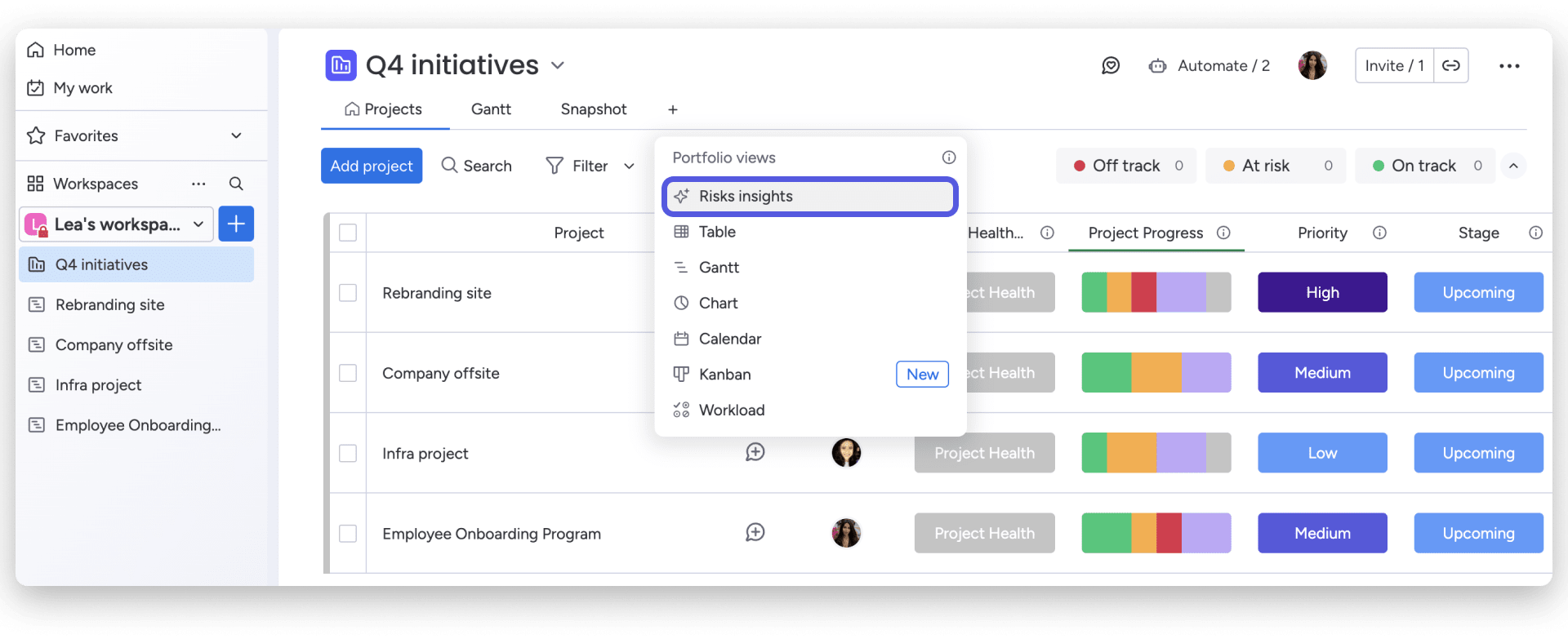
Risk management goals help organizations proactively identify, assess, and address potential threats. These objectives ensure business continuity, safeguard assets, and minimize disruptions, building resilience in a rapidly changing environment.
- Develop a comprehensive enterprise risk management (ERM) framework by Q3 2025
- Reduce business continuity risk exposure by 40% through improved contingency planning
- Conduct semi-annual cybersecurity threat simulations and response training
- Establish a cross-functional risk oversight committee
- Achieve a 90% risk mitigation rate for all critical business processes
- Implement predictive analytics for early detection of operational risks
- Maintain an up-to-date risk register reviewed quarterly by leadership
Marketing strategic goals
Marketing strategic goals drive brand visibility, audience engagement, and pipeline growth. Setting ambitious targets around campaigns, content, and reach fuels demand generation and positions your business as a market leader.
- Increase brand awareness by 60% in core markets by 2027
- Grow qualified inbound leads by 35% through AI-driven targeting
- Launch a global content marketing strategy in 5 new languages
- Boost social media engagement rates by 50% within 2 years
- Implement marketing automation to nurture prospects and shorten the sales cycle by 20%
- Host 10 industry webinars annually to generate high-quality leads
- Secure 5 national media features for key executives and brand stories
Supply chain strategic goals
Supply chain strategic goals focus on building resilient, efficient, and transparent networks. These outcomes reduce costs, improve delivery, and ensure your products reach customers reliably — no matter the circumstances.
- Reduce supply chain lead times by 30% through process automation
- Increase supplier diversity with 25% of spend directed to minority-owned businesses
- Achieve 98% on-time delivery rate across all distribution channels
- Establish end-to-end supply chain visibility with real-time analytics by 2026
- Reduce inventory holding costs by $2 million annually
- Digitize 100% of procurement processes to improve transparency and speed
- Develop a supplier risk scoring system to proactively manage disruptions
How to set strategic goals that drive results
Setting effective strategic goals requires a systematic approach. Follow the following steps to create objectives that inspire teams while remaining achievable with a success plan.
Step 1: Conduct strategic analysis
Start by understanding your current position. Examine internal capabilities, competitive landscape, and market opportunities.
Your analysis should cover:
- Internal assessment: Current strengths, weaknesses, and competencies
- Competitive analysis: Market positioning and advantages
- Market evaluation: Growth opportunities and emerging trends
- Resource review: Available budget, talent, and capacity
Step 2: Define your vision and mission
Strategic goals must align with your organization’s fundamental purpose. Clear vision and mission statements provide context for evaluating potential goals.
This strategic alignment ensures that achieving goals advances your core mission rather than just hitting arbitrary targets.
Step 3: Identify strategic priorities
Not every opportunity deserves strategic focus. Evaluate potential areas and select those with the highest impact relative to available resources, then develop a plan of action. Also, consider impact potential, resource requirements, probability of success, and strategic fit when making these decisions.
Step 4: Develop SMART strategic goals
Apply the SMART goals criteria to transform priorities into focused and easily actionable objectives:

Step 5: Create implementation roadmaps
Break long-term objectives into manageable phases. Include clear ownership, resource allocation, and milestone tracking.
To create detailed project roadmaps and track progress against strategic milestones, use smart software like monday work management to see how daily work contributes to long-term objectives.
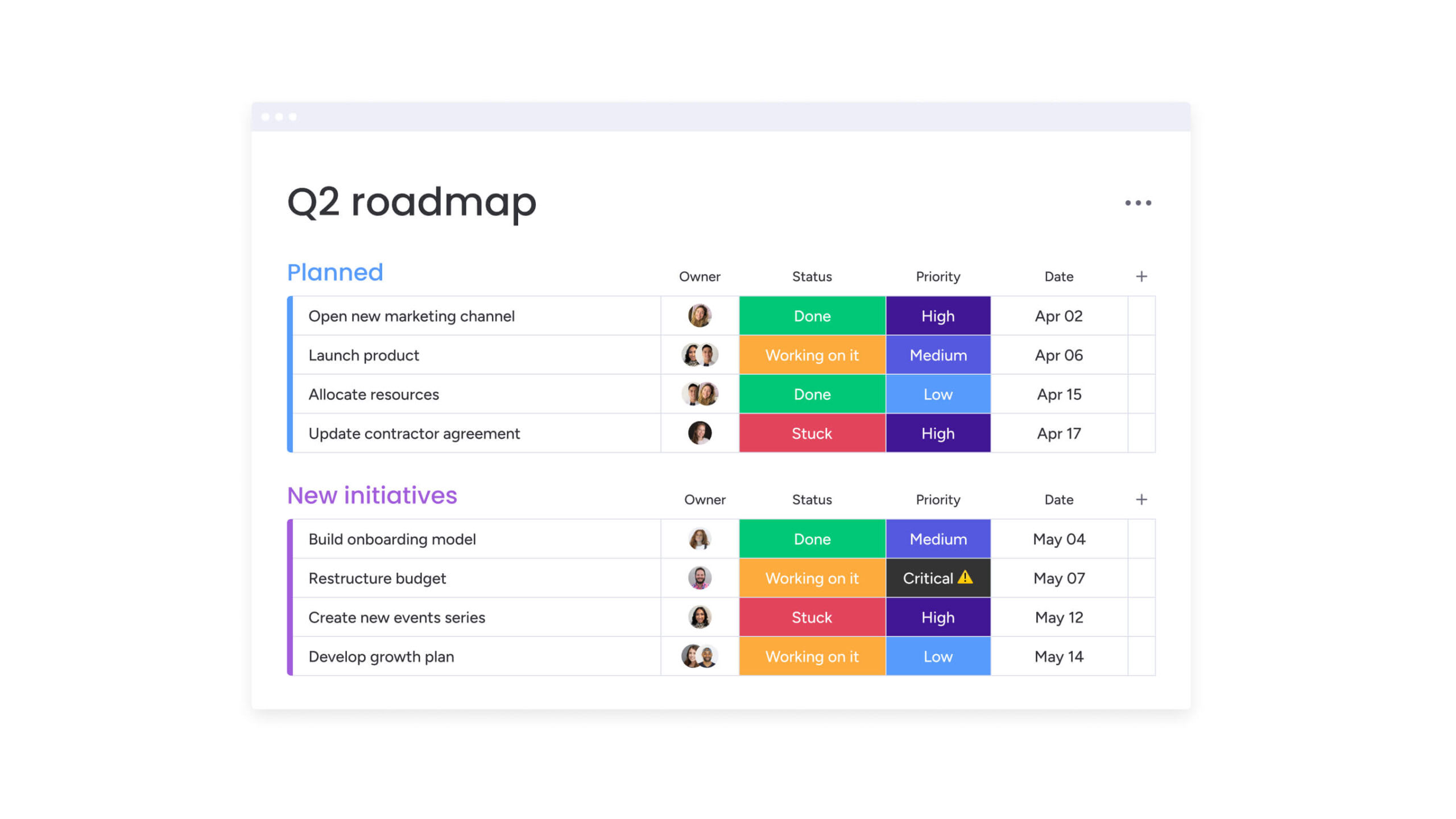
Ways to prioritize and align strategic goals
Organizations often identify more opportunities than they can pursue. How do you choose which goals to focus on first? Here are some tips:
- Calculate expected ROI: Estimate the financial returns of each strategic goal, including both direct gains and indirect value creation. Use this insight to prioritize initiatives with the highest business impact.
- Assess resource requirements: Evaluate the human, financial, and technological resources needed for each goal. This helps spot potential conflicts early and prevents overcommitment.
- Evaluate market timing: Factor in external conditions and competitor activity. Some opportunities require fast action, while others allow for a longer runway.
- Consider organizational readiness: Review your company’s current capabilities and culture. Some goals may need preliminary development or upskilling before you can realistically tackle them.
- Balance quick wins with long-term impact: Combine short-term, achievable objectives that build momentum with larger, transformational goals that drive lasting change.
- Align with stakeholder expectations: Gather feedback from investors, customers, and employees. This ensures buy-in and helps close the perception gap between senior leaders and individual contributors.
- Build in flexibility for change: Design goals to adapt as circumstances evolve. Regular reviews and modular planning let you adjust course without losing momentum.
Transform strategic goals into measurable outcomes with monday work management

Setting strategic goals is just the beginning. Achieving them requires seamless execution, ensuring teams stay aligned, progress is visible, and your organizational strategy evolves with real-world conditions. That’s where AI-powered monday work management becomes your strategic advantage.

By breaking down high-level goals (like becoming a market leader, launching new products, or achieving carbon neutrality) into actionable initiatives and daily tasks, monday’s AI tools help you spot risks earlier, surface insights automatically, and keep everyone focused on the right priorities. Whether your focus is operational excellence, market expansion, customer experience, or sustainability, monday work management gives you the clarity and intelligence to translate vision into impact.
Here’s what you can accomplish with monday work management:
- Connect daily work to strategic objectives: Link every project, task, or KPI to your organization’s top priorities so everyone understands their impact.
- Align teams around shared goals: Centralized planning and AI-driven updates keep leadership and individual contributors on the same page.
- Allocate resources effectively: Use smart capacity planning to visualize budgets and timelines across all your initiatives.
- Track milestones and mitigate risk: Automate progress check-ins, get AI-powered alerts for potential delays, and adjust plans in real time.
- Drive accountability and celebrate wins: Clear ownership, transparent progress, and auto-generated reports make achievement tangible.
Take your strategic goals from vision to impact
To compete today, it’s not enough to set ambitious goals like achieving 99.9% uptime, expanding into new markets, or hitting sustainability benchmarks. Success depends on your organization’s ability to turn strategy into action, adapt quickly, and maintain momentum across every project and department.
From high-level planning to ground-level execution, monday work management provides the tools to collaborate, prioritize, and deliver results that move your business forward. No more siloed teams, manual updates, or missed opportunities — just unified progress toward your most important objectives, all easy to track in a single goal management software.
If you’re ready to make every strategic goal actionable and measurable, it’s time to try monday work management.
Try monday work management
FAQs
What is an example of a strategic goal?
An example of a strategic goal is “Achieve carbon neutrality across all operations by 2028.” This goal spans multiple years, requires coordinated effort across departments, and represents fundamental transformation in how the organization operates.
What are the 4 types of strategic goals in business?
The 4 most common types of strategic goals in business are growth, efficiency, customer satisfaction, and innovation.
- Growth goals expand revenue or market share.
- Efficiency goals optimize operations.
- Customer satisfaction goals enhance relationships.
- Innovation goals advance capabilities.
What are the 8 major areas for strategic goals?
The 8 major areas for strategic goals include market expansion, product development, customer experience, financial performance, talent management, innovation, operational efficiency, and sustainability. These areas cover the primary dimensions where organizations seek transformational change.
How do strategic goals differ from operational goals?
Strategic goals differ from operational goals in scope, timeframe, and impact. Whereas strategic goals span 3-5 years and focus on transformation, operational goals cover shorter periods and maintain current performance levels, similar to short-term goals.
Why are strategic goals important for business success?
Strategic goals are important because they provide direction, align resources, and create accountability for long-term value creation. They help organizations prioritize initiatives and measure progress toward meaningful outcomes that drive competitive advantage.
How often should organizations review their strategic goals?
Organizations should formally review strategic goals annually with quarterly progress check-ins. Major revisions should only occur when significant market changes or capability shifts warrant strategic direction changes.
